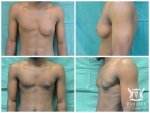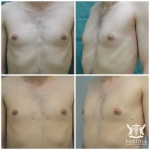Male Breast Reduction or Gynaecomastia – the medical term for this procedure – is an operation to reduce the appearance of breasts on a male. It is not as common as female breast reduction surgery however, there are a huge amount of men in the world who suffer from this devastating anatomical issue.
This debilitating problem is not only hard to cover up, but it also damages a man’s self esteem and confidence. Men who have this issue can feel like they have had their masculinity take away from them and seek advice on how to get rid of them.
The colloquial term for gynaecomastia is ‘moobs’/ ‘Man-Boobs’ and this can be used to bully and upset an individual, which can in turn destroy a man’s pride. Over 40 to 60% of men suffer with Moobs. This is a huge amount of men who suffer with larger than average breasts.
When going to a doctor, the initial response is to do everything possible to reduce the size of the individuals breasts naturally, either by eating healthily, exercising regularly, and changing their whole lifestyle and if it still has not worked, seek the advice of a plastic surgeon.
Why have Male Breast Reduction (Gynaecomastia) Surgery?
Over the years, our diets have become unhealthier which means that consequently our lifestyles have changed, therefore so too have our chest and waist sizes. The men who choose to have plastic surgery to remove their larger than average breasts, have normally reached breaking point.
A male breast reduction is extremely similar to a female breast reduction. The decision to have this surgery should not be taken lightly. The procedure begins by the surgeon making a small incision around the lower half of the nipple area. Once the incision is made the surgeon will place a small, thin piece of plastic tubing into the fatty area of the breast. This thin plastic tube is known as a ‘Canulla’ and it is this tubing which is attached to an extremely strong vacuum which then sucks the fat out of the breast cavity. This technique of sucking the fat out of the breast area is known as liposuction. Once the liposuction is complete, the surgeon will remove the tube and stretch the skin down to the incision mark and cut off the excess skin and fatty tissue. Once this is complete, the surgeon will stitch the wound up using surgical sutures. As the surgeon has sliced through so many layers of muscle, there are quite a few layers to stitch up.
Risks and Complications
Generally, modern day surgery is considered safe.
As there are with all general anaesthetic cases, risks and complications come hand in hand with plastic surgery procedures. These risks and complications include a reaction to the anaesthetic, this can be a possible complication so make sure that you have gone through all of your allergies with not only your plastic surgeon but also your anaesthetist. Approximately one-third of patients who receive an anaesthetic during surgery will experience “anaesthesia sickness” or post-operative nausea and vomiting (POVN).
Asymmetry is also another potential risk which is caused when scar tissue forms after healing which in turn causes one side to become larger than the other. This complication may result in an operation to remove the scar tissue.
Keloid scaring is also a complication of having this surgery. This is where the incision site becomes red and raised and can result in the scar having to be cut out and re stitched. If you are prone to keloid scaring ensure that you discuss this with your surgeon prior to the operation so that they can suggest ways in which to reduce the chances of this kind of scar occurring.
Nipple displacement is another complication. Even though it is extremely rare, it can still occur causing one breasts nipple to be lower than the other. In addition to nipple displacement, inverted nipples are another potential problem as certain muscles and fibres are holding the nipple in place and during the surgery these get severed leaving the nipple to become inverted.
Q. What can cause ‘Moobs’?
A. Around 40 to 60% of men will suffer with ‘Moobs’ at some point in their lives. This is due to a number of factors. During the ages of 12 to 16 males go through puberty and this can result in a large amount of fatty tissue growth within the chest area. As these males grow up a few manage to grow into their body’s meaning that the ‘moobs’ grow out and do not affect the individual. However, for some this is not that easy and the issue persists all the way through to adulthood. Another factor is age. As the male gets older, the fat in the chest area can enlarge due to a reduction in male hormones. Finally, a huge increase in weight can cause a buildup of fat in that area and even an extreme weight loss can cause the skin to become saggy resulting in left over fatty tissue in the breasts. These are just some of the reasons why ‘man boobs’ arise.
Q. I have gynaecomastia and I am also extremely over weight. Will this surgery help me to lose weight?
A. Unfortunately, this surgery will not help you lose weight. As there is an element of liposuction which can be used to remove the fat in the chest area that is the only place you will lose the fat from. It is not advised that you use liposuction to lose weight anyway. If you are having issues with losing weight, then you should consult your doctor who will put you in touch with a nutritionist.










